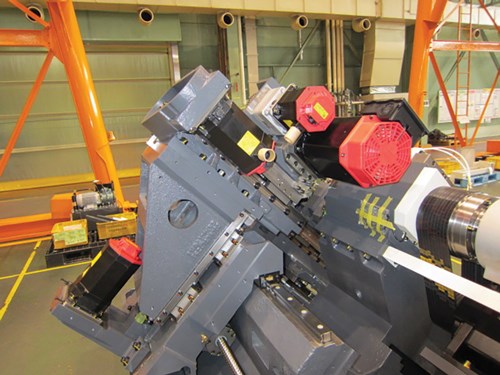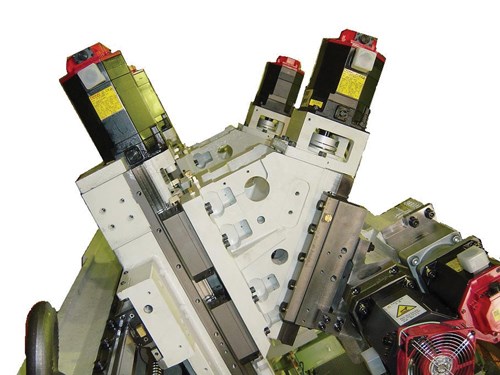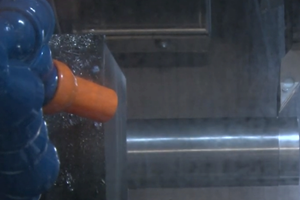The Y of Multitasking
The Y axis has some primary capabilities that make it extremely efficient and cost effective in multitasking operations.
Today’s competitive global market demands that manufacturers continually examine ways to be more efficient and save costs. Profitability often comes down to what the cost per piece is to manufacture.
For those doing multitasking turning and milling operations, it pays to examine the benefits of using the Y axis to reduce the cost per piece. The Y axis has some primary capabilities that make it extremely efficient and cost effective.
Simplifying Milling Operations
The Y axis was first created to solve the difficulty in programming as it relates to polar interpolation. With the Y axis, the need for polar interpolation is eliminated, and operations are streamlined, resulting in faster cycle times.
There are two types of Y-axis designs for turn-mill centers. Both are strong options for most applications, and some advantages exist for each type.
First is true Y. True Y design performs better when doing three-axis profiling or in applications where cutting speed is a factor. In this design, the Y axis is located 90 degrees to the X axis. The true Y is better for profiling because it is a direct servo move that is not in combination with an X + Y move.
Second, wedge (or compound) design costs less to manufacture and helps contribute to a more compact machine construction. In this model, the Y axis is not located at 90 degrees to the X axis, and compensation is required for determining the final position by moving the X axis to the proper point. Both axes move together to create the proper off-center movement. In most applications, a wedge design is sufficient for locating the
final position.
Increased Tool Variety and Options
With an increasing number of complex parts to produce, manufacturers know that having the ability to make a part complete on one machine is much more productive than using multiple machines to make one part. Facilitating the ability to machine complex parts complete on one machine, the Y axis supports a variety of tools that enable it to perform a range of operations. An infinite amount of milling can be achieved and tight tolerances can be met. The Y axis provides much better control over the size of a feature because it enables programming and adjusting the position of the tool, resulting in an accurate feature size. Conversely, without a Y axis, the size of the tool dictates the feature size and often results in a dimension being out of tolerance because of the overcut of the tool’s deflection.
Also, pocket milling a rectangular or square feature can be achieved, and deburring processes can be performed. Without the Y axis, these operations may have to occur on separate machines, resulting in lost productivity and increased cost.
For manufacturers using some of the latest multitasking turning centers, a Y axis may be available on both the upper and lower turret, enabling pinch milling for significantly more efficient operations. Having the ability to use the Y axis simultaneously on both spindles can reduce cycle times and increase quality. Increasing productivity even further when machining high volumes or a family of parts, three-turret machines are available with a Y axis on each turret. Figure 1 (below) breaks down cost per piece when using one, two or three axes.
Helical Interpolation
The Y axis allows for helical interpolation, which requires simultaneous motion in multiple axes—X, Y and Z is possible. This three-axis profiling can be used for thread milling, for making holes and for creating circular ramping.
The Y axis eliminates the need for many secondary operations. When using the X axis to generate a flat on a round piece (polar interpolation), the resulting surface is concave and also has a small witness mark because of a dwell in the X-axis movement. The Y axis solves these problems.
Off-Center Features
The Y axis optimizes processes when doing off-center features on a part. To complete a part on a machining center, the Y axis is a requirement when making any off-center features. Also, the Y axis can put a tool on center to improve tolerance and cutting condition in instances where there is a stack-up error for center location.
|
Process |
Material Cost at $0.70/lb |
Cycle Time at 0.028 per Second |
Cost of Leased Machine per Piece |
Total Cost per Piece |
|
Twin Spindle/Twin Turret/1 Y axis |
$2.00 each |
$9.74 (348 sec.) |
$5.66 |
$17.40 |
|
Twin Spindle/Twin Turret/2 Y axes |
$2.00 each |
$8.45 (302 sec.) |
$4.51 |
$14.96 |
|
Twin Spindle/Twin Turret/3 Y axes |
$2.00 each |
$6.30 (225 sec.) |
$4.43 |
$12.73 |
Figure 1. Here is a cost-per-piece evaluation using 1, 2, or 3 Y axes on a leased machine. The application includes 24,000 custom connectors per year, 12L14 steel material, 2” bar size, and $100 per hour labor rate. Although a 3-axis is most expensive to lease, the cost to manufacture is the most cost effective.
Related Content
Video Tech Brief: Twin-Turret, Twin-Spindle Lathe Machining
This machine model features roller linear ways to accommodate low-frequency vibration technology to minimize chip size.
Read MoreWhen a CNC Turn-Mill Doesn’t Turn
A shop in Big Sky Country uses a B-axis multitasking machine to produce complex, prismatic medical parts that require no turning complete from barstock.
Read MoreOEM Moves From Automation Implementation to Refinement
Automating challenging parts for full-weekend automation requires substantial process refinements that can significantly boost throughput.
Read MorePMTS 2023 Product Preview: High-Volume Turning
Learn about some of the latest high-volume turning solutions that will be on display at PMTS 2023.
Read MoreRead Next
The Evolution of the Y Axis on Turn-Mill Machines
Introduced to the turn-mill machine tool design in about 1996, the Y axis was first used on a single-spindle, mill-turn lathe with a subspindle. The idea of a Y axis on a CNC originated from the quality limitation of polar interpolation and the difficulty in programming, not from electronic advances in controls or servomotor technology as one might commonly think.
Read More5 Aspects of PMTS I Appreciate
The three-day edition of the 2025 Precision Machining Technology Show kicks off at the start of April. I’ll be there, and here are some reasons why.
Read MoreA Tooling Workshop Worth a Visit
Marubeni Citizen-Cincom’s tooling and accessory workshop offers a chance to learn more about ancillary devices that can boost machining efficiency and capability.
Read More









.jpg;maxWidth=300;quality=90)




.jpg;maxWidth=300;quality=90)








